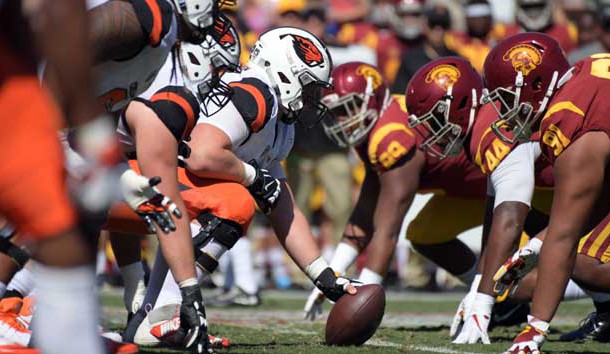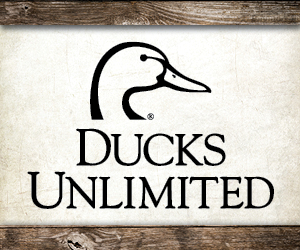
Oct 7, 2017; Los Angeles, CA, USA; General overall view of the line of scrimmage as Oregon State Beavers offensive lineman Sumner Houston (52) snaps the ball against the Southern California Trojans during a NCAA football game at the Los Angeles Memorial Coliseum. USC defeated Oregon State 38-10. Photo Credit: Kirby Lee-USA TODAY Sports
LOS ANGELES — Pac-12 football has a longstanding reputation of high-scoring games and wide-open offenses. USC and Utah — picked to finish first and second in the Pac-12 South media poll prior to the season — defy the reputation.
The No. 13 Trojans (5-1, 3-1) and Utes (4-1, 1-1) can put up points, evident in scoring averages of 35.5 and 32 points per game, respectively. However, each owes its success in the season’s first half to defenses with similar traits.
“Physical guys up front,” said Stanford coach David Shaw, whose team is the only opponent to face USC and Utah this season.
“(Rasheem Green) from USC, he was tough for us to handle. Utah has a couple guys up front, you try to block them and you think you have them, and at the last second you don’t have them.”
Keying off the performances of their defensive lines, USC and Utah head into Saturday’s matchup at Los Angeles Memorial Coliseum boasting impressive statistics. The Utes allow 3.4 yards per carry and 108.8 rushing yards per game, ranking No. 20 nationally against the run.
USC has been tremendous in generating turnovers, tying Washington State for most in the Pac-12 with 15. The Trojans’ consistent pass rush causes fumbles and creates opportunities for interceptions.
Safety Chris Hawkins credited defensive coordinator Clancy Pendergast for consistently introducing new looks that opponents “have never seen before,” thus throwing quarterbacks out of rhythm and opening up chances for takeaways.
“Coach Pendergast, I’ve got a lot of respect for,” Utah coach Kyle Whittingham said. “I think he’s one of the top defensive coaches in the country.”
Utah has generated 14 turnovers.
“Looking at Utah’s defensive front: No. 1, they’re huge,” Helton said with a laugh. “They’re 300 (pounds) across the board, so really terrific size.”
Utah features tackles Filipo Mokofisi (6-foot-4 and a shade below 300 pounds) and Lowell Lotulelei, a prototype NFL prospect at 6-2, 320 pounds. The Utes also use Leki Fotu, a 6-5, 323-pound presence on the interior.
The Trojans cannot match the Utes’ size up front, but Whittingham said he sees “philosophical” similarities in their schemes.
The two sides have also faced similar adversity, with two of their top pass-rushers — defensive ends Kylie Fitts for Utah and Porter Gustin for USC — sidelined due to injury.
USC has been without Gustin since the second half of the Trojans’ Sept. 16 win over Texas. In that time, Christian Rector has emerged as a primary playmaker along the USC front, playing a variety of positions.
“The thing that impresses me is how football-smart he’s been in playing those positions,” Helton said.
“He’s been able to back up Rasheem Green when he’s been dinged. He’s been able to play opposite of Rasheem on third-down situations in the three-technique, to get a man-on-man matchup on the guard. And now with Porter down, he’s been able to move out to defensive end and be productive.”
Rector played his best game statistically last time out, recording seven tackles, including one for loss, and recovering a fumble in USC’s 38-10 win over Oregon State on Saturday.
Utah lost Fitts on Sept. 22 in a win at Arizona. Defensive end Bradlee Anae had his most productive outing in that Arizona contest, recording four tackles and a sack.
Injuries also shape the offenses taking the field Saturday in the Coliseum. USC’s tenacious pass-rush will be in pursuit of one of two quarterbacks: Troy Williams or Tyler Huntley. Huntley was injured at Arizona, forcing 2016 Utah starter Williams back behind center.
Williams struggled in Saturday’s loss to Stanford, going 20-of-39 passing with a touchdown and two interceptions.
USC sustained a number of injuries along the offensive line in recent weeks. Veterans Toa Lobendahn, Viane Talamaivao and Chuma Edoga were all scratched from the lineup either before or early into the Sept. 29 loss at Washington State. Lobendahn returned last week, and Edoga should start against Utah, but Talamaivao is lost for the season due to his pectoral injury.
The line will have to protect quarterback Sam Darnold, who hasn’t posted Heisman-like numbers. He is 136 of 210 for 1,705 yards and 12 touchdowns, but the interception total — nine — has been troublesome. He threw for 316 yards and three touchdowns versus Oregon State, though.
“Once we get the flow going, we’re going to be a hard team to stop,” he said. “It’s just a matter of when.”


